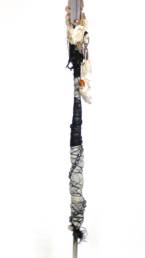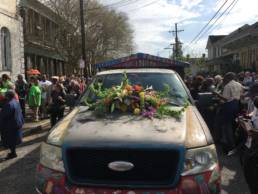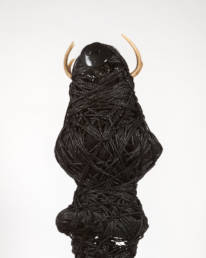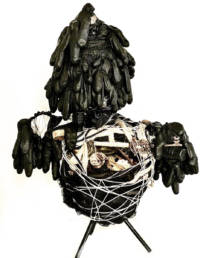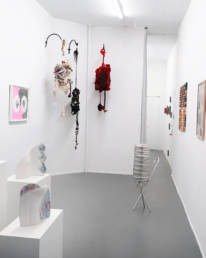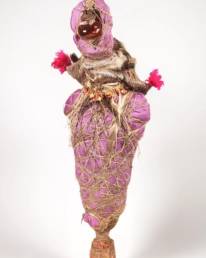Concept
In the interest of elevating ritual energy, I would like to share a project entitled ‘Sanctity,’ which is comprised of a family of sculptures inspired in the ritual of “ex voto anatomica” (offerings in petition for gratitude or intervention) The family of works are comprised of a large sculptural installation built to move in procession, anchored by a triptych of sculpture, and supporting works of smaller-scale sculpture and works on paper. The works built for ‘The Procession’ are embedded in support structures used in human engagement toward reinforcing movement fused to imprints of healing and restoration. The totemic works, designed to move, detach at varying parts in the sculptures. The procession moves and sculpture provides a circular boundary for a ritual activation to be performed. The work can either be moved to an alternate space to bring the energy from the processional activation to a new space or return with it to the initial installation.
Process
I am interested in energy. It is the “material” I fuse, bind, and compress into sculpture. It is process-driven; objects are found and isolated in groups where the energies laced in objects imbued with human engagement are fermented. They are then transformed from their history of use or intent. The melded energies, over time, begin forming relationships. From these materials, I build bonds in a process of physical isometric binding, without glues or screws. The work is built in transference of human strength, locking in vectors of tension. The way I work draws from ritual in working with my intuition in a meditative process, binding connections with no armature. Seeing gravity and negative space as the support, I replace a traditional building in order to carve the space around the form. The works often carry hidden, activated energies. In this part of the experiment, I select objects, which I perceive to be filled with human engagement, collecting the vibrations in the work to build from energy. Each are filled with many narratives, which the viewer can connect to in the energies’ transformation.
Materials
‘Sanctity’ is built in found objects intended to reinforce healing. They were fermented in confinement and isolated with the energies imprinted on these objects to promote health or facilitate function, such as a prosthetic or brace. The materials are fermented together to create the collective of assemblage works each independently hold many layered, combined energies. The work is composed of materials gathered over a decade in the American South. The found objects and worn textiles are imprinted in experience, each woven primarily with women’s hands. The materials are manifested in historical process of collective experience over time.
The woven creations speak in layers to lost traditions, phantom memories, and patterning in systems. Found objects are activated with the energy of use, held or worn, transformed in a reflection on ritual through figuration. Each object carries its own story, melding into narratives revealed in the forms. The piece extends its reach with a procession of sculpture and includes corresponding works on paper, divided into drawings made in gratitude for the anatomy illustrated or those that reflect on the act of intervention for healing.
.
The Procession
‘Sanctity’ was initially presented with an installation of sculpture anchored with a trinity of sculptures entitled ‘Introspection,’ ‘Devotion,’ and ‘Resilience.’ The work was unveiled in a community space devoted to the promotion of healing. It was activated with a ritual performed by the host, and Healing Center priestess, performing a ritual head washing ceremony for the public alongside the installation. ‘The Procession,’ was a ritual activation of the installation with ten performers moving in a series of choreography, holding ten sculptures built to move in public procession to from the exhibition space to the neutral ground, or median, led in ritual song by a healer in the community. The priestess of the Temple of Light performed a ritual blessing, surrounded by the totemic sculpture from ‘The Procession,’ encircling a tree whereby the sculpture created the space for the ritual.
The public was invited to participate and at the ritual’s conclusion, the procession transitioned from exterior public space to the interior of Barrister’s Gallery. In that destination, sculptures were placed within predetermined spaces. A second, smaller ceremonial blessing concluded with the processional work joining the previously installed supporting works. Smaller sculptures and drawings alongside an exterior installation entitled ‘Sanctity Excavated,’ which was built in the grotto with the purpose of anchoring the exterior to interior, extending and reinforcing the work. The original installation in the Healing Center was reconfigured with the works that did not travel in procession and remained on view. The project concluded with a public panel discussion public centered on the question of “What is sacred space?” moderated by Andy Antippas with participants and cultural bearers in the community.
Totems
Activation
‘Sanctity’ was initially presented with an installation of sculpture anchored with a trinity of sculptures entitled ‘Introspection,’ ‘Devotion,’ and ‘Resilience.’ The work was unveiled in a community space devoted to the promotion of healing. It was activated with a ritual performed by the host, and Healing Center priestess, performing a ritual head washing ceremony for the public alongside the installation. ‘The Procession,’ was a ritual activation of the installation with ten performers moving in a series of choreography, holding ten sculptures built to move in public procession to from the exhibition space to the neutral ground, or median, led in ritual song by a healer in the community. The priestess of the Temple of Light performed a ritual blessing, surrounded by the totemic sculpture from ‘The Procession,’ encircling a tree whereby the sculpture created the space for the ritual.
The public was invited to participate and at the ritual’s conclusion, the procession transitioned from exterior public space to the interior of Barrister’s Gallery. In that destination, sculptures were placed within predetermined spaces. A second, smaller ceremonial blessing concluded with the processional work joining the previously installed supporting works. Smaller sculptures and drawings alongside an exterior installation entitled ‘Sanctity Excavated,’ which was built in the grotto with the purpose of anchoring the exterior to interior, extending and reinforcing the work. The original installation in the Healing Center was reconfigured with the works that did not travel in procession and remained on view. The project concluded with a public panel discussion public centered on the question of “What is sacred space?” moderated by Andy Antippas with participants and cultural bearers in the community.
Sanctity Extended
Sanctity Extended
By: Eric D. Bookhardt | Source: The Gambit Weekly | Jan 30 – Feb 5, 2018
Kristin Meyers’ ‘Sanctity Extended’ expo at Barrister’s Gallery is inspired by Europe’s ‘ex voto anatomici’ grottos and local equivalents like our St. Roch Chapel, places where body parts are immortalized as icons of healing. Here, Meyers’ array of bound figurative and reliquary forms reflect her own personal archetypal trinity expressed as her ‘Introspection, Resilience, and Devotion’ mixed-media sculptures. ‘Introspection’ – a white fabric and lace upper female torso with surreal anatomical protrusions affixed with gauzy white wrapping – is emblematic for its exploration of the ancient art of binding as a way of focusing spiritual energies. An adjacent grotto fashioned from the gallery building’s antique brick walls recreates a sense of the ancient Roman Catholic catacombs where the bones of saints and well-connected mortals were preserved for posterity. Although Meyers’ ‘Sanctity’ exhibition, like King’s ‘Swamp Goddess’ installation, reflects traditions that date to antiquity, both perfectly complement our Carnival season’s celebration of ancient deities like Bacchus, Proteus, Iris, and the like.
Art Contemporain : l’esprit “espiègle” de La Nouvelle-Orléans s’affiche hors les murs du Prospect 4
By: Yann Perreau | Source: Les Inrockuptibles | February 20, 2018
Immerse yourself in the art scene of New Orleans on the occasion of “Prospect”, the triennial of contemporary art, an opportunity to rub shoulders with the less marked territories of the city.
It is a message written in capital letters and black, on two white walls, which border the Mississippi. “If you don’t know what the South is,” begins the first. “It’s because you come from the North” ends the sentence on the one on the left. Designed by Swedish artist Runo Lagomarsino on the occasion of Prospect 4, the work sums up the state of mind of the inhabitants of New Orleans towards the event: mistrust and suspicion. Here is the intrinsic limit of this type of event when applied to a medium-sized city like this. What do they ultimately bring to the local art scene?
“Speak out about the local context”
When it was created in 2006, Prospect came very appropriate to shake up the hierarchy of major contemporary art biennials, Venice, Whitney New York, etc. An innovative, life-saving project in a city in shock, still traumatized by Hurricane Katrina. Prospect has even boosted a half-mast economy and developed a type of tourism hitherto unknown in Louisiana: that of contemporary art lovers – philanthropists, patrons and wealthy collectors.
A Sense of Place
Ritual processions move collective energies forward with a series of ritual repetitive actions embedded with a unified focus and choreography of forward movement focused in activating the energy of the “subject” and intentions of which the procession is performed. I believe New Orleans reigns as the center of processional activation in the United States. It is a place where rituals and traditions are embedded in its history and are preserved in contemporary life through activations of living culture bearers. The heightened energy of spirit individually and contributions in action to the collective thrives in the city. If you drive with me in New Orleans and a procession appears, it takes precedence over all else and I pull over, jump out of my car, and will move to the end of the journey, diving into the collective. I’ll then walk back to the car eventually, but you never know how much distance passed while the entire group “danced it out.”
New Orleans is host to many processions and is globally connected through Carnival. The ritual ceremony activated in procession of collective intentions transformative energy and personal release. New Orleans proudly presents the pageantry and participatory procession in vast expressions of the many Krewes of revelers, all uniformly tied to the rituals and dates determined by the church. The city shows up in support with a creative force that palpitates through as the communities of revealers prep for months to arrive at the climax of Mardi Gras. And as of Wednesday, tradition requires you must now repent.
The black masking Indians hold space in a living sacred ritual of exquisite divine heights in expressions revealing a pageantry sewn in woven meditative thought and collective bonds. The sacred evening of Saint Joseph is for me, the most significant ritual procession in New Orleans. On the eve of St. Joseph, beaded messages move floating in ritual space as the feathered beaded suits dance in the wind. The procession reveals depths of strength to endure through unending oppression built in bonds of time and devotion expressed territorially in this sacred processional. In this regard the act links community in recognition of the brutal history with a transformative expression toward overcoming and elevating the strengths and beauty, which is undeniably divine. There is an elevated level of spirit in the synchronized activity of the group, with a focus on the collective goal, allowing links to build together the energy of each person in the collective spiritual engagement. For decades, I photographed these activations, documenting for friends, grateful to know “spy boys” and feel blessed to have the honor to document the glory of their beaded suits and headdresses. The honor has allowed me access the commitment and passion the culture bearers undertake.
The concept of the Second Line is a procession, which serves in many incarnations, one of which being the jazz funeral, where the established ritual repetition of cadence determines the choreography and pace. The procession will “roll out” playing St. James Infirmary, for example, with the somber tone beginning in a slow crawl and building in tempo. The musicians determine the movement and transition from mourning into celebration. The first person I met in New Orleans was the King Ernie K Doe and danced in the procession of his collective spirit when he was called home. I live in a neighborhood not far from “the cut” in the sacred path of many of the second lines. I wrap my rambling love of the collective energy in a procession by confiding one entry of my bucket list was to be awakened by The Northside Skull and Bones Gang, who moves across the historic Treme neighborhood at dawn on Mardi Gras day, initiating the energy work. I begins with a loud knock on the front door, at which time opening the door reveals a burgeoning crowd following in procession. One is expected to immediately exit your home and pay homage to the procession (me in my pajamas) and therein lies a sacred New Orleans experience, rising with with the messaging to be good to each other while initiating the day of celebration.
I live in a neighborhood not far from “the cut” in the sacred path of many of the second lines. I wrap my rambling love of the collective energy in a procession by confiding one entry of my bucket list was to be awakened by The Northside Skull and Bones Gang, who moves across the historic Treme neighborhood at dawn on Mardi Gras day, initiating the energy work. It begins with a loud knock on the front door, at which time opening the door reveals a burgeoning crowd following in procession. One is expected to immediately exit your home and pay homage to the procession (me in my pajamas) and therein lies a sacred New Orleans experience, rising with withthe messaging to be good to each other while initiating the day of celebration.
Ancestral Ritual
Procession is embedded in my personal history. The procession of Santissima Maria Assunta in Arasi, occurs in the province di Reggio, Calbria in Southern Italy. It is a ceremony of ritual engagement that takes place on August 15th in the small village and birthplace of my mother. She was one of the children who participated in the procession, which continues to this day and is said to be an even larger event in the sleepy southern landscape villagers from surrounding towns come to celebrate. The ceremonial activation is a time of energizing the village and surrounding communities. A significant component of all processions is found in collective effort. In small towns, the entire village will contribute what they can and in so build cohesive bonds in the process even before the ritual act. Preparations extend to throughout all homes as everyone wants to present their best offering when the elevated life-size Saint passes by, aloft and in theological definition emanating the Holy Spirit. The saint is carefully cleaned, dressed, and prepared. The church is purified in cleaning, usually by the children and others sometimes paint fresh gesso or perform a select restorative act in the church. Feasts are prepared and shared, often specific to the event. All these repeated movements are part of the building of collective energy. In the anticipation of the procession and ceremony behaviors shift toward building collective effort, offering the participants sacred energy in return.
The consistent date of the ceremonial event heralds the advance preparations, building toward the ceremony, which binds the group. The process itself is physically, mentally, and spiritually demanding. The route is predetermined and repeated over time, etching patterns of energy in the space they occupy. Pending the movements and distance, it can include an element of physical endurance, contributing to binding the group as one. The physical demands of processions can also be elevated to atone in ritual processions seeking penance in spiritual systems, demanding physical extremes for atonement in kneeling crawling stairs, rites of flagellation, binding, or piercing, all as extended acts of observance from the devotee. The unifying narrative of the celebration is focused intention on the “sacred object” tied in traditions. The participation imposes a collective psychic understanding, promoting empathy for one another and serves as incarnation of devotion. The procession is spiritually designed to connect and seek soulful revelations. At its height, it is a portal to transformation in a synchronization of energies activated toward progressing together.













